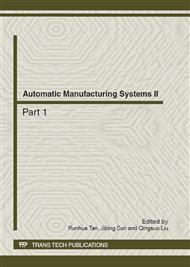[1]
G. C. Goodwin, S. F. Graebe, and M. E. Salgado, Control System Design.Prentice Hall, 2000.
Google Scholar
[2]
S. Skogestad and I. Postlethwaite, Multivariable Feedback Control Analysis and Design.Wiley-Interscience, 2005.
Google Scholar
[3]
D. Gu, Robust control design with MATLAB.Springer, 2005.
Google Scholar
[4]
M. KODA, "Sensitivity analysis of singularly perturbed systems," International Journal of Systems Science, vol. 13, no. 8, p.909–919, 1982.
DOI: 10.1080/00207728208926398
Google Scholar
[5]
R. Doraiswami and L. Cheded, "Identification of linearized models and robust control of physical systems," Recent Advances in Robust Control - Novel Approaches and Design Methods, 2011.
DOI: 10.5772/17453
Google Scholar
[6]
I. Shaw, Fuzzy Control of Industrial Systems Theory and Applications.Kluwer Academic Publishers, 1998.
Google Scholar
[7]
Y. Huang, D. Wang, and P. Han, "Fuzzy logic self-tuning pid control for superheated steam temperature system," Electric Power Science and Engineering, vol. 3, p.37–40, 2004, (In Chinese).
Google Scholar
[8]
J. B. Hoagg and Dennis.S.Bernstein, "Direct adaptive command following and disturbance rejection for minimum phase systems with unknown relative degree," International Journal of Adaptive Control and Signal Processing, vol. 21, no. 1, p.49–75, 2007.
DOI: 10.1002/acs.945
Google Scholar
[9]
G. Fusco and M. Russo, Adaptive Voltage Control in Power Systems: Modeling, Design and Applications, Advances in Industrial Control.Springer Verlag, 2007.
Google Scholar
[10]
J. Han, "A class of extended state observers for uncertain systems," Control and Decision, vol. 10, no. 1, p.85–88, 1995, (In Chinese).
Google Scholar
[11]
——, "Auto-disturbance rejection control and its applications," Control and Decision, vol. 13, no. 1, p.19–23, 1998, (In Chinese).
Google Scholar
[12]
Y. Huang and J. Han, "Analysis and design for nonlinear continuous extended state observer," Chinese Bulletin, vol. 45, no. 21, p.1938–1944, 2000.
DOI: 10.1007/bf02909682
Google Scholar
[13]
J. Han, "From pid to active disturbance rejection control," IEEE Transactions on Industrial Electronics, vol. 56, no. 3, p.900–906, 2009.
DOI: 10.1109/tie.2008.2011621
Google Scholar
[14]
S. Nazrulla and H. K. Khalil, "Robust stabilization of non-minimum phase nonlinear systems using extended high gain observers," in Proceeding of 2008 American Control Conference, 2008, p.1734–1739.
DOI: 10.1109/acc.2008.4586742
Google Scholar
[15]
L. B. Freidovich and H. K. Khalil, "Performance recovery of feedback-linearization based designs," IEEE Transactions on Automatic Control, vol. 53, no. 10, p.2324–2334, 2008.
DOI: 10.1109/tac.2008.2006821
Google Scholar
[16]
L. Praly and Z. Jiang, "Further results on robust semiglobal stabilization with dynamic input uncertainties," in Proceeding of 1998 IEEE Conference on Decision and Control, vol. 1, 1998, p.891–896.
DOI: 10.1109/cdc.1998.760806
Google Scholar
[17]
C. Zhao, "Capability of adrc for minimum-phase plants with unknown orders and uncertain relative degrees," in Proceedings of the 2010 Chinese Control Conference, Beijing, China, July 2010, p.6121–6126.
Google Scholar
[18]
J. Han, Active disturbance rejection control technique.Beijing: National Defense Industry Press, 2008, (In Chinese).
Google Scholar
[19]
Z. Gao, Y. Huang, and J. Han, "An alternative paradigm for control system design," in Proceedings of the 2001 IEEE Conference on Decision and Control, vol. 5, Orlando, Florida, USA, 2001, p.4578–4585.
Google Scholar
[20]
Y. Huang and W. Zhang, "Development of active disturbance rejection controller," Control Theory and Applications, vol. 19, no. 4, p.485–492, 2002, (In Chinese).
Google Scholar
[21]
G. F. Franklin, J. Powell, and A. Emami-Naeini, Feedback Control of Dynamic System.Prentice Hall, 2002.
Google Scholar


